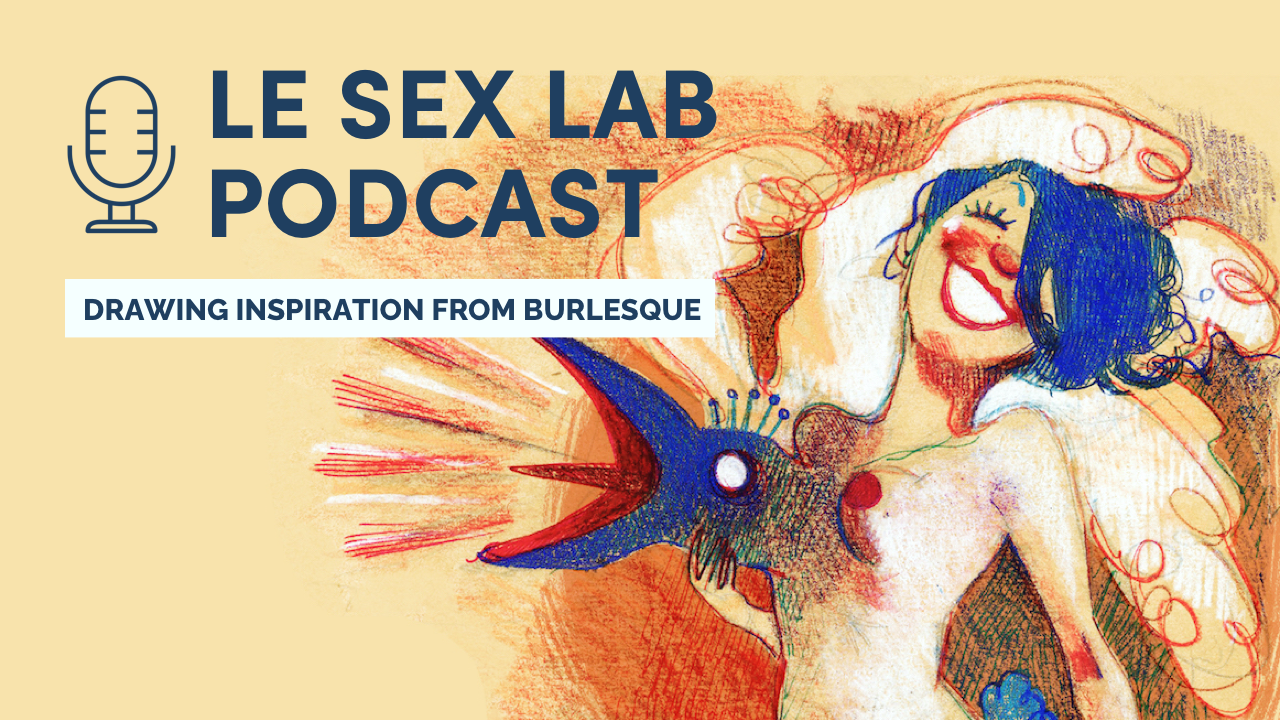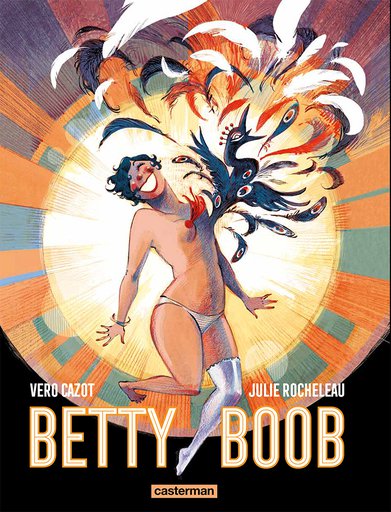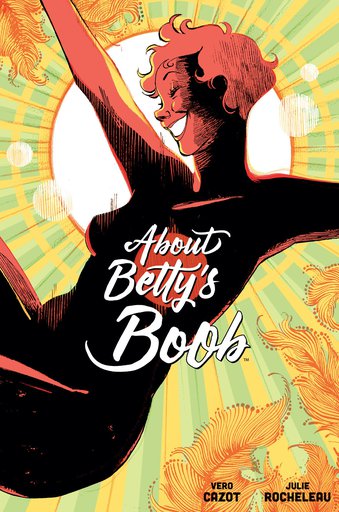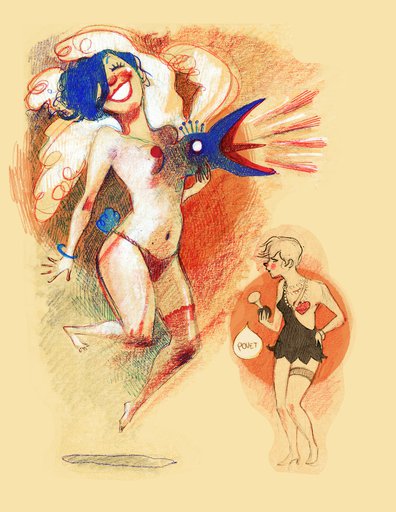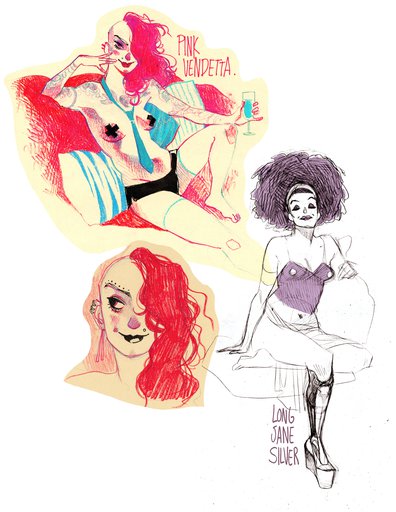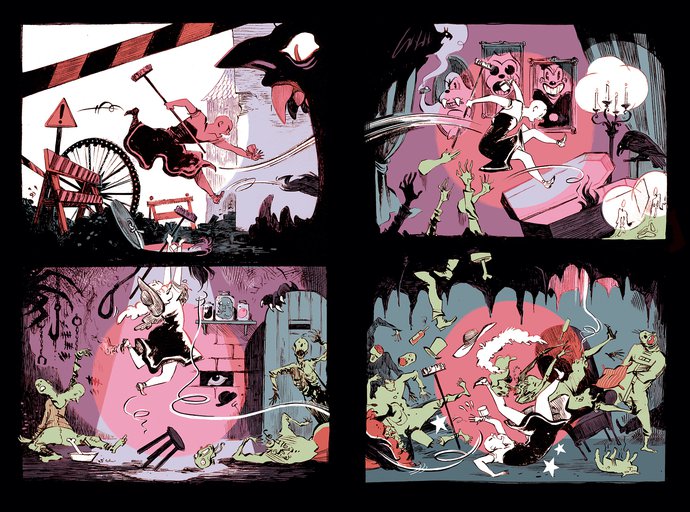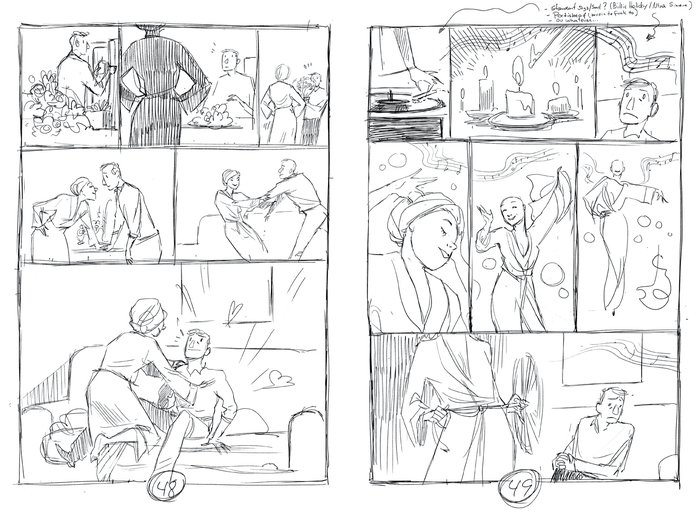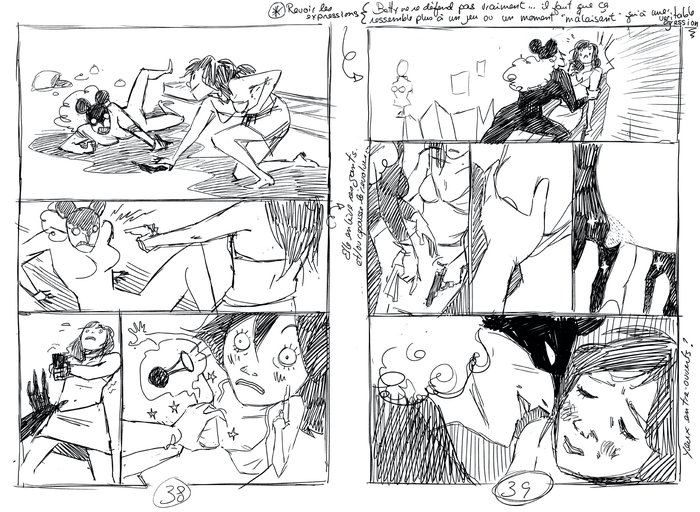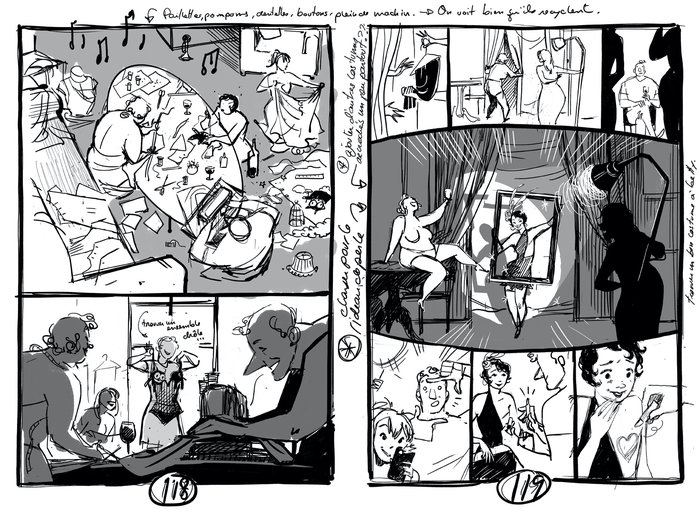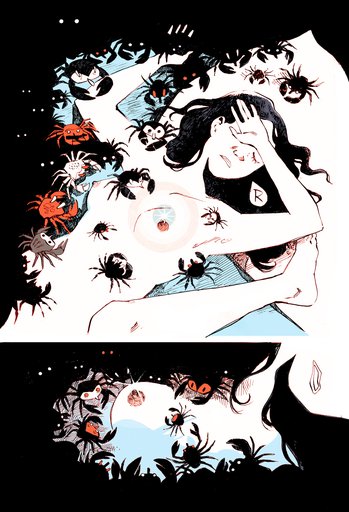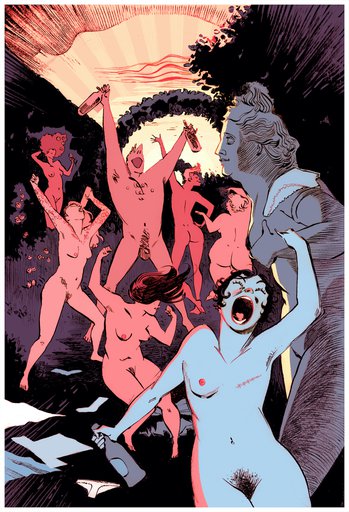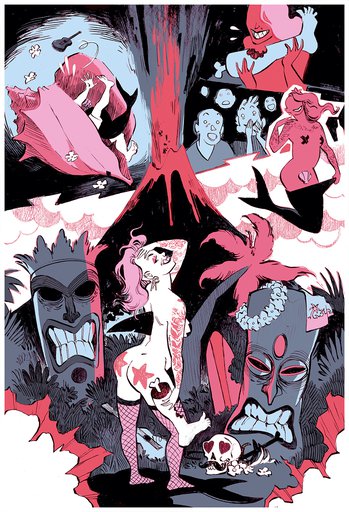Drawing Inspiration from Burlesque
By: Abby DivDate: July 27, 2020
In Le Sex Lab's podcast we are talking about the inspiration and sex positive messaging behind the comic book Betty Boob. In the lab to chat about the illustration is artist of Betty Boob, Julie Rocheleau
Abigail Div
Hello, everyone. We're going to be talking today about the inspiration and sex positive messaging behind the comic book illustration. Betty boo. I'm your host, Abigail Div, Founder of Le Sex Lab, an experimental Media Lab exploring sexuality. Today's interview will explore the following: What is the creator of Betty Boob's background? How did the collaboration between author Vera Cazot and illustrator Julia Rocheleau come about? How did the design and the comic book come about? And how did burlesque influence the work? What were some of the challenges also was spreading the body positive messaging underlined in Betty Boob? And with me today to talk about the illustration is artist of Betty Boob, Julie Rocheleau. Welcome Julie!
Julie Rocheleau
Hello!
Abigail Div
Yes, and welcome to Le Sex Lab's podcast. To start with, I thought we chat about who you are and your background in animation. So first let's chat about how did you start drawing? What is your background in the arts?
Julie Rocheleau
Well, I started drawing when I was a wee little kid like my like most kids draw, but drawing comic books and reading comic books was my one favorite thing that I would do all the time. And it was pretty much self-taught for my childhood and my teenage years. When it came time to pick a college, I went into this brand new program, 2D animation. It was very new, and we were kind of the guinea pigs in the very late 90s. And when, you know drawing was my life basically. It could take on many shapes, I could do many jobs with it. I started with animation. And I worked as a freelance storyboard artist and character designer for eight, nine years. I also did some illustration on the side for little kids novels and board games. I also tried to do my own independent films, animated films.
Julie Rocheleau
But I was not feeling always too comfortable in the animation world, you need to be very patient. Most of the time, you have to work with big teams as well unless you are doing more, you know, artistic stuff, and I couldn't really find my place in this world. So I eventually got the chance to sign up for my very first comic through people I knew for illustration gigs. This person knew I liked comics and asked me if I want to try my chance on one and of course I said yes. So my first comic book was called La Fille Invisible. It was about an eating disorder. It was written by a journalist, forgot her name, Émilie Villeneuve. That was 10 years ago and I really enjoyed the experience. I learned a lot. I felt I could express myself more through comic arts and so I tried to sign for more projects with different writers and that brought me to Fantomas and than to other books and then eventually to Betty Boob.
Abigail Div
That's a great segue into how you came into contact with the Paris-based artist and author Vero Cazot. How did you come across her work? And what was his division of labor to creating Betty Boob?
Julie Rocheleau
Well, Vero came to see me, we knew each other a little bit before because she's actually the girlfriend of another one of my writer with which I worked in the past, a completely different kind of story. But she knew my work. I know a little bit about her work as well. And she knew I really liked these fast paced and kind of over-the-top, ridiculous, surreal action sequences because she knew I liked old movies and vintage fashion and such. I don't think she knew that I did burlesque a little bit before but I don't know probably she felt I knew a little bit about this stuff. So she came to me with this idea. She already wrote the script. She had the entire story. It was a really nice surprise to receive that in my mailbox. I read it, didn't get it at first, we did some back and forth, we tweaked some little things to make it you know, real tight and when we presented it to the publisher he was very enthusiastic as well. Then you know, once most of our work was already done, then I went on my own to create the visual characters, did a little bit more research and then did the actual comics.
Julie Rocheleau
She came with the idea first. She wrote the script. And then I came into the picture with kind of having the fun part to do. All the rough stuff was already done.
Abigail Div
It sounds like you got the fun aspect of the creation where she got the labor aspects, but I'm sure that it goes both ways.
Julie Rocheleau
Yeah, of course, it's not really that. She loves her creation. And, you know, art is not always fun and games, it's actually really the case. And we, we did that to communicate a lot even though the script was done, but I was calling to her often because I wanted to make sure that I got it right. And that my idea was too extravagant or it's really hard to find the balance, you have to make it look like only one person was involved while we are two people you know. It has to look like it came from the same brain, it's coherent both in the story and in the voice will give the story, in this case the images. Not sure if that's clear. So it's really a team effort and you have to make sure you really understand and there's a good chemistry between the artist and the writer.
Abigail Div
And that's very much like sex in that there has to be a good rapport, as this is a podcast all about it. Celebrating it, of course, and all of its facets. But yes, you have to, in some ways have the good marriage between the writer and the illustrator to create a cohesive narrative.
Abigail Div
I'll say that I actually came across Betty Boob while I was actually on a recent trip to Montreal in a small independent bookstore. And sex-related graphic novels are fairly common in anything from indie to mainstream bookstores in Canada and Europe. And they usually have this very small niche, but they have a robust selection of work that ranges from anything from comic novellas to taking on some very heavy hitting topics. And for those of you who are not familiar with the narrative of Betty Boob, it surrounds a woman's experience with breast cancer and her journey to re-empowering herself through her discovery of burlesque. Maybe you could tell me a little bit more about the narrative itself and the storyline.
Julie Rocheleau
Yeah, well, Vero, she's a very positive person. And she wanted to make a very positive and uplifting book. And that's what I didn't get at first, because yeah, we tackle all kinds of really dark or serious or difficult subjects like what you said, illness, cancer, heartbreak, losing your job, self-esteem issues, body issues, gender issues, mourning even. So, at first, I thought it was supposed to be one of these books. I like drama and I for some reason, I thought, you know, this would be a kind of a heavy book, but Vero was like no, no, we're not, we're not doing that book, we're doing a very positive, feel good book. It has to give hope. And it has to be funny. And it has to be the exact opposite of whatever you're doing. That's the actual strength of the book. Otherwise, I don't think it would have succeeded at all. I don't think it would have been a very good book. So she was completely right. Then we wanted to, you know, give hope to people want them to feel hopeful, whether they are going through a crisis or that they are already feeling good. We want to make this object light, I don't know how that sounds, really but when when I finally got it, then it was an absolute blast to do it because it did me a lot of good. Sometimes I was crying in at a time laughing because you really get into the skin of your characters.
Julie Rocheleau
And I'm glad because of feedback, we were not sure at first, you know, it's kind of a strange object. But the feedback was very positive from women who had had or are having to deal with cancer, husbands and fathers and children, teenagers who are having their own, are discovering themselves. They also like this book, for everybody has a reason to find themselves in like this book. So it's a very good book for.
Abigail Div
Certainly not an easy topic to tackle and not to do in an empowering and yet lighthearted manner. Great. Let's then talk a little bit more about the inspiration behind the illustration. Julie with your background in animation, your work has been commissioned by authors with such a wide range of interests. Their topics are equally varied for any since you've done an illustration for youth novels like the Second Floor of the Ocean and the Strange Cat Girl, but then you've also done a trilogy with the Wrath of Fantomas about the evil character with 100 faces, who is debatably one of the first ever super villains. Just a really build up your resume you've also had a caption of you as a surfboard painting contest and the NCS festival to celebrate Popeye's 90th anniversary. With such a range of work , what drew you to Betty Boob?
Julie Rocheleau
Well, there's a lot of things that drew me to Betty Boob. Sometimes it's a bit of a question of timing because I do like to try new things all the time and to diversify my work. And I guess you know, Vero just came to me with the script at the right time and I love the little slapstick fun. I love the you know, I always had, I really like burlesque and theater and all these pagentry and all these aesthetic. And I love that message in the book of hope and love and sexiness and funny character and I could take a lot of liberties with this visual. You know, if I had to do it again today I would, I would end it would be a completely different book because there's so many directions you can take. It's really fun for an artist to be given this kind of project.
Abigail Div
It seems like a beautiful mixture of art and commerce, of course and making a book that could be commercially viable. Wonderful. Well, let's talk about the actual design. Your work looks loose and airy, but it's also very methodically executed. How did you come up with the design that you use for Betty Boob?
Julie Rocheleau
Well, the art itself is a very good answer, but it's just you know, the normal evolution of my work. Yes, I drew for children and for adults and I did some very violent comics and other very more sweet and introspective ones. But they all kind of know it's not like I changed my style that much from one to the other. I kind of tweaked it and of course, after years going by, so I get more mature. You know, I was at this point with Betty Boob.
Julie Rocheleau
Then of course I did some research. Also just before Betty Boob was set in Montreal in the 40s. And the book I did before was a trilogy called the Wrath of Fatomas and that was set in Paris in the 1910s. It was very action packed and kind of garish, you know, very theatrical, and Betty Boob, kind of takes from both of those projects. And it's not, you know, part of this, part of that. It's really a mix of both.
Julie Rocheleau
It became a different thing. It can be touching and intimate, and it can be surreal and wacky at the same time. If somebody would have presented me this project a few years before that, I would not have been able to do it that way. So I'm very proud and I was very lucky. It got me at the right time. And hopefully my other projects after that are also gaining in building on the learning I did on Betty Boob.
Abigail Div
Sounds like it's a natural evolution and maturation of the works to the point that it hits a reality of what it came to be as opposed to a divergence or a, you know, like a sidestep to what you've already been doing or had already been doing.
Julie Rocheleau
Right. I don't really go looking for a new design because then it feels forced and it's rarely coherent or cohesive but yeah, I still get influenced. And this helps with the research and I like this costume or I like that. I like the burlesque posters I looked at and maybe that's more or less consciously came and changed the way I worked a little bit. So you, you cherry pick stuff and sometimes that will work, sometimes it takes years before, you know, showing somewhere you work. And you don't remember where you got that, but it's not something that you precisely and consciously, it's not something you right away go looking for. It would feel artificial, I think.
Abigail Div
Yeah, it sounds more naturally like a curation of ideas that have accumulated over time that you can then pull from a repository of as opposed to drawing directly from an inspiration or trying to take a diversions from the natural evolution of your work as an illustrator. What were some of the inspirations that you did draw upon when you were looking at, designing the characters, drawing the characters for Betty Boob.
Julie Rocheleau
Well, you know the name, Betty Boob, it has nothing to do with the the character other than the play on words, but I couldn't help myself. I mean, the character didn't deal 1930s Fleischer's studio characters Boop, that everybody knows about. She has nothing to do with this story. It's just a fun play on the name but I couldn't help myself to go and try to hint all the time at either somewhere in the background or in some time the way the characters are acting or the expression to somehow now they look a little more cartoony. Now, you know, this is a reference too. I'm kind of a geek. So there is a reference to it some Buster Keaton films. I love this old-timy stuff. So and since it's a silent comic there's barely any word in it. So you have to go about it with pantomime, you have to be over-the-top expressive with your characters. So even though it takes place in present day Paris, there was space for me to hint at those references on old cinema and old cartoons like ones from the Fleischer Studios. And then of course, I looked at photos, artistic photos of burlesque, and went to see shows and got a lot of books on the libraries. And one of them in particular, called Good Girls, Bad Girls by Maly Siri, which is a very famous, very nice pinup artist. So now I could see how all the classic, let's say the classic poses of pinups, classic get up and hair, you know, I didn't have to use that precisely, because burlesque can go in a lot of other directions. But you know, these were good bases for the aesthetic. I could hint at that as well. So it was also a book where you could put a lot of eye candy in it. So you know, why not do so. She was an influence.
Abigail Div
Wonderful well going from just the text, which is powerful but very concise, you wouldn't very readily know that burlesque was the fully-formed imagery behind the creation of the illustration. How did you and Vero work together to come up with the characters behind Betty Boob?
Julie Rocheleau
This is kind of two questions in one. With the characters she was working the script, Vero. She had kind of an idea of what the character would look like, as she kind of, she sent me pictures of actors, and I don't quite remember which ones because that was many years ago. I do know Maggie Gyllenhaal and she was the main inspiration for Betty. She plays she plays in Donnie Darko. She plays the older sister. She plays in the movie called Frank, many other ones. She has very, very Betty Boob looking face actually, very expressive, very cute. And I like it, but kind of unconventional, you know, she's very pretty, but not your usual babyface most people drawing comic books. Anyway, I like her a lot. And she was the main influence for Betty then I got to play with my own, you know, my own ideas.
Julie Rocheleau
Like I'm a big fan of 80s supermodel Grace Jones. I love everything that songwriter Björk does with her costumes and the visual of her albums. You know, and, and many other things and at the end, not everything shows up in the book and some of it is you know, it's mixed with other things. You don't really recognize it. But it's a big mix of a lot of things like that. We looked at photos and costumes, we decided which character would wear what. At one point, I realized that I have to go very fast because I didn't have that much time to do the research. So basically, I sent some sketch to Vero and just to know what she thought, and she said, I like this one better, I like this one better, and then I would do some more. And then I would just go and start the book, even though not everything was in place. Because you know, as you draw your characters, you kind of learn a little bit more about them as well. So you might not stick to the first design anyway. It's more of an organic way, I guess to create your characters and have them develop. I'm sure when they will was writing her story she had her own ideas in her head and I did something that you know, I'm not psychic. So of course I I did something probably completely different. And it's a mix of all these ideas.
Julie Rocheleau
For your comment about the text which is concise. Yeah. In the book, there's almost no words. It's not quite a silent comic because there are few caption lines, kind of like in a silent film. Sometime you flip the page and it's all dark with one sentence. And at one point, there's a burlesque show and the show host presents different characters. And she's hosting the show. And she talks. And she sings. And it's funny because a lot of people didn't realize that there were no words, no dialogues at all in the book until they got to that point. And they say, oh, word bubbles. Why do I feel weird? So they didn't think something what was missing, even though the character were not talking and this is a choice Vero did as she was writing the story because she didn't feel she could write dialogue that that would have the right impact for this particular story. For those she can write great dialogue. But for this one, it would have felt, you know, either maybe fake because I didn't have cancer, she didn't have cancer. Maybe she thought it was too serious. But it would have made the whole story heavier. That's for sure. And my language for me, it's image and already did a silent film in the past. And she knew I like this kind of stuff. So she presented with this silent film in a book, basically. And we think it works better this way without any words. It's more open to interpretation, I guess. And you don't use words all the time, where it's gonna be beautiful. But in this case, we put our money on image and image only. And we were glad we made that.
Abigail Div
Well, that's definitely a efficacious decision, as you were just telling me that I was thinking, having read the book, I mean, I will say reading quotes having read or look through the pages of the book, I would not have noticed that either until almost after I read the entire comic that it was very much visually heavy piece and it works perfectly as such. It doesn't intrude that there isn't text.
Abigail Div
Well burlesque plays an essential role as you're just saying and Betty we discovering herself and her self-worth. She finds a troupe in mid novel of independent performers who are led by their captain, if you will, their hostess Long Jane Silver. The choices though are interesting. And not by chance, of course, in terms of the influences. Did you do a lot of 'research' by seeing a lot of burlesque to creating the work?
Julie Rocheleau
I did, it was a perfect opportunity. I loved it already, but now I had an excuse and I went, of course with my boyfriend. He didn't know anything about us, but he really was enchanted and got really curious. So we met some people, artists of burlesque, asked questions and when I was way earlier to this to this project, when I was young 20s I did took some business class, and I did some dress on burlesque posters for a small troupe in Montreal. So I knew a little bit about the right expressions and the pauses. But of course, it's more maybe geared towards classical burlesque. And we got to look at costumes and what's what's happening behind the scenes. So yeah, I knew that was part of the research says, of course.
Abigail Div
I was definitely hands on experience to inform all the research. What is the burlesque like in Montreal, relative, of course, to the time that you were developing the book?
Julie Rocheleau
Well, I know Montreal has a long history of burlesque. It's not a huge city, of course, but back in the first half of the 20th century was the place to be for the nightlife and people were coming over Canada and the Americas and Europe for burlesque performers such as Lili St Cyr and Red Velvet Cabaret, a very famous cabaret. They don't even exist nowadays, but they've been replaced by different kinds of venues. Some of them are an institution as well. Now, the LGBTQ plus community is very much alive and well in Montreal. And those are kind of festival of course, but a lot of burlesque events are part of one or the other of these festivals. And of course, there is the Montreal festival itself. And there's also the Fringe Festival. I think these are the two biggest ones but you know, not being part of really this community. I you know, don't take my word for it. But definitely, you know, they're pretty nice events and the Montreal Burlesque Festival, maybe the more classical one with the pearls and lace and high heels and very classy, there with a champagne bottle waiting for you at the VIP table and you have to dress well. And you have all kinds of more grungy, unconventional neo-burlesque. I have a friend who's called Beauty Beignet and she has her own production house called Burlesgeek where they do geeklesque which is inspired by comic books and culture and video games and such. There's also something on Gorelesque which is more inspired by horror films, trailers and stuff like that. There's probably plenty other sorts of way to make your life your own. So yeah, and others also the Dr. Sketchy. This was created in Brooklyn actually. It's an art movement of live drawing sessions where you have a model. These are sexy, theatrical live sessions. Now it's all over the world, but we have one also in Montreal that's very popular. Well, of course now we can go at the moment. Hopefully, we will soon. Yeah, there's always something at every season burlesque-related in Montreal.
Abigail Div
Yeah so as this is being recorded, we are still in the heart of the corona virus pandemic. So unfortunately, there's not going to be a lot of live burlesque happening at the moment or for a few months, projected out. New York City is also one of the homes of burlesque in the neo-burlesque movement. And that holds that anything from as you're saying that Dr. Sketchy's night, here in Brooklyn, where there's live drawing sessions by burlesque performers and something from really elaborate outfits with boas and ties and laces to some very simple drawing nude sessions as well. I've seen the full range of it, which is fascinating to see the community that's built up around it. And just like Montreal, New York City is the home for if you want to see burlesque on any other given night of the week, say when there's not a pandemic happening if you can find it. If so, you want to find somebody taking off their clothing it exists. It's not too hard to find. So it's wonderful to see that the community is thriving and well, and that there is a positive movement towards also being inclusive in it to including other communities, in the boylesque movement, in the LGBT community as well it's very inclusive in that sense of exploring your sexuality and being, you know, open to who you are and not trying to propose another person's set of conventions. And what they think is beauty. So how did you incorporate some of these influences into the illustration?
Julie Rocheleau
Well, you know, I don't think you will really find specific things or if they are, I don't remember. But are you see in the book is a is really it's a big mashup of things. I thought that oh, this is cool. This is nice. Let's put it together. Let's use this. Let's use that and we just created scenes where, the artists, the characters are performing. We kind of invented routines that we could do that I haven't saw in life, I don't think it would be very practical or even doable at all. That being said, I remember now having seen artists doing crazy stuff on stage, crazy things. So maybe. I don't know. Maybe our articles were not that original. But not really a documentary so we didn't have to actually invent something that's doable or possible in real life. We just had fun with it. It's a comic book you know.
Abigail Div
You can defy gravity if you want to. Oh, wonderful. Well, and finally, I'd like to chat about some of the challenges actually the sharing this very body positive messaging throughout the world.
Abigail Div
Betty Boob sends a very whimsical, yet very powerful message about the relationship that women have with their bodies, and also their bodies have two other people. Betty's employer and boyfriend both reject the heroine for her single boobness as a rejection in some ways of her sexuality, but Betty finds herself again in the end of the narrative through her own self empowerment in burlesque. While this messaging resonates with many places, and people, there are places where I'm sure the book can't be found. What are some of the challenges that you found for making the book about female sexuality?
Julie Rocheleau
Well, I think the first thing that comes to my mind is well, like the conventional way of showing female figures in comics and in popular culture in general still today, and, of course, I'm also a product of my generation. So I grew up reading comic books where females were drawn females, women and girls and, and older women, if they even exist in comic books, you know, they were always drawn a certain way. And I have to kind of fight it off. Because what we wanted was diversity. We wanted, you know, they are characters, we want them to have a personality, with a body with personality with a story. So yeah, we wanted diversity with different bodies with different personalities, different ages, different weights and heights and different ethnicity, different fashion style, and, you know, body language. How, you know, how do they dress up and undress? How do they, you know, they don't talk, but they they act and they interact. So yeah, I'm proud of what I did. But I realized, even then, I didn't realize that wasn't not quite feeling that I, I didn't feel free to do exactly as I wanted to do. I was thinking maybe too much of the reaction of the comic readers who are used to sort of which was a mistake. Because you don't know, that's not how you change things, that's not how. If I had to do it today, it would be different of course. And if I had to do it again in 10 years, it will be a whole other thing. So I'm still, I love my characters, and I had the good feedback about them. I still think it may be a bit too conventionally pretty though. But, you know, that's, that's how you grew as an artist, as well. This book was, when I was working on it, four or five years ago now. I met so many people and then who have show you how they approach these questions that we're asking ourselves more and more now. Finally, so, so yeah, that was the first challenge.
Abigail Div
Yes, and then there are many, many challenges, but I'm just gonna try not to take your whole evening on it. The second thing I think was probably the love scenes because I wanted them to feel you know, sincere, you know, all the fantasy when she you know. Betty, she imagined herself with this guy that's really turning her on. And she's having this stupid little film in our head about prancing around naked in a flowerfield and she's so goofy, but I didn't want it to go into the, you know, something that wasn't me. Even though there's a lot of very nice erotic art to go around that I could have looked at to inspire myself. I was afraid that it would, if I try to do that it will look tacky or insincere. It will it will be kitsch, it would, you know, be not real. So I didn't know because I'm not, I do some erotic art, sometimes there's a erotic art festival in Montreal and I try to participate every year. But I'm not considered an erotic artist. Most of my work has nothing to do with that. So, with these characters that I grew attached to, and having them, you know, flirt together and have sex together, I wanted to have, how would they make, not just like figurines or statues making love, no. These are fictional people but to me, they had to feel real. To me, they meant something. So yeah, I just decided to not at all look at ertoic art. There's a lot of well known names in comics, that do adult comics, sexy comics, and I just willingly forget all about I knew about them and know, Betty, she's not a sex goddess. She not a supermodel. She's cute. Yes, but she's clumsy. She's funny, but you know she kind of person sometimes I guess she doesn't know that's in the book but I imagine she can pick her nose when she thinks nobody's looking. She falls on her face a lot. She's only got one boob and she doesn't want to apologize for that. She doesn't have always in know sometimes I like to draw bodily hair, you know, because her armpit is not all that freshly shaved because she didn't go home that night okay. Sometimes it happens. And her new boyfriend is this huge guy, he's like a circus strogman. He's actually a boylesque and when you see him naked, he has this tiny, tiny wieners, really small penis. And it doesn't matter and she's not laughing at him. She doesn't care. They're having just as much fun and they're pleasuring themselves. You know, it doesn't matter a lot because our bodies are capable of love. And so I have to draw those two together and make them without, without being. yeah, without without being all flowery and cute, but still will be happy for them.
Abigail Div
That makes entire sense actually. I think the best turn on an audience can have is one of authenticity and naturalism. If it feels forced, then it looks like it's been set up as a scene as opposed to fluidly and naturally. And I think, if anything, a response for viewing, watching, consuming anything in erotic nature is to tap into a visceral response, a natural response to the body naturally has. So if you create a fictitious scene that isn't relatable to the audience, that it's targeted at that then it's not going to hit the mark and come off as being erotic
Julie Rocheleau
And the word I was looking for is relatable.
Abigail Div
Well, following that, are there places where you can't find your work? Right now markets are just not accessible to the messaging?
Julie Rocheleau
Well, I not sure, of course there, you know, there are countries, places in the world where sex and nudity is either, you know, sometimes restricted by law, sometimes it's completely taboo, you can find it anywhere. So, of course, Betty Boob cannot be sold in these countries, or maybe it's circulating somewhere. But you know, you probably cannot find it there. Otherwise, I don't really know because, it's well, it's the distributors knows where my book is going. But the very fun things about this book is that it's pretty much wordless. And it is translated in many languages already, but it's the easiest thing to translate and you can really read it in any language. So if you are in Amsterdam, and you get it in Dutch you can read it doesn't matter which language it is really and you got it in French right?
Abigail Div
yeah while I was in it I have the the French version which even if you don't know French, you can you can piece together. I think most of the language.
Julie Rocheleau
That being said, the US version is titled About Betty's Boob. They changed the title so there wouldn't be a mix up with the ongoing comic about the character, the Fleisher character Betty Boop. So, you know, it would have been very confusing otherwise and the cover is actually very different. I had to make a new one, I guess, for an American, sensitive, you know. What's appealing to American eyes is not always the same as what's appealing to an European sensitivity let's say. I Actually like the US version better even though because it's still sexy and colorful, you do see a little less of skin because she's kind of silhouetted, black silhouette with only your face and smile. Graphically it's more to my taste, but we ultimately we have to do this so the booksellers in the US could easily advertise it. While on the French version, she was not completely naked but you have boobs on the cover. So maybe that's not something you would not in every store, anyway, you can easily put it in a window. So we have now with this other cover, it's more you, don't have to put it in the back with a black cover on top.
Abigail Div
So that might help it sell more you never know.
Julie Rocheleau
You never know.
Abigail Div
What's taboo is more desirable in many ways in terms of trying to create enticement from what you don't know versus what you can readily access, so it's interesting to see how the covers have changed even just crossing a continent, a border really, in terms of the sensitivity really, culturally are instilled, of course, from one facet to another. And if you're a consumer of erotic art or even just a piece of art that deals with sexual content or sexuality, then you're pretty familiar with seeing, you know, any level of nudity on it. But if you're not readily exposed to it being normalized to it is something that you have to do over time and may not be easily accessible for a general audience.
Abigail Div
Well wonderful. Thank you, Julie, for joining me today to talk about Betty Boob. If you like what you hear please join me again next week for another creative feature on Le Sex Lab.
Recent Posts
Who Are Kink Collective in NYC?
Sept. 22, 2021
Making their Mark in Australian Adult Cinema
Sept. 14, 2021
Sci-Fi & Sex in a Galaxy Ruled by Goddesses
June 18, 2021
How to Find Multiple Ways to Pleasure?
May 25, 2021
The IKEA of Kink Furniture
April 5, 2021
